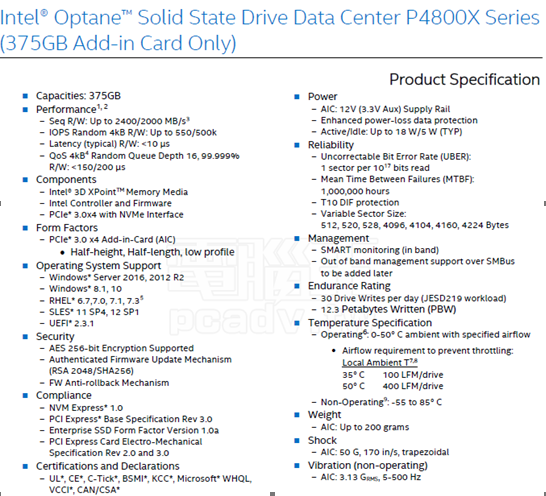[Abstract] In terms of transmission performance, the official data given by Intel is a read speed of up to 2400MB/s and a write speed of 2000M/s. At present, the price is certainly not cheap.

Mangofish Intel and Micron announced the joint development of new 3D XPoint flash technology in 2015, but the Optane series of flash memory using this technology was dragged from the end of 2016 to 2017, and Intel has finally launched it recently. The first 3D XPoint product P4800X, its related product information has finally surfaced. It is worth mentioning that compared to NAND flash memory technology, the theoretical 3D XPoint transmission speed and service life is 1000 times that of the former, and the storage density is 10 times. Digitally speaking, most of the SSDs on the market today are truly explosive. Transmission speed can even be used as memory.
However, the reality is that 3D XPoint technology may not be so unmatched by Intel at the present stage. From the related documents, the storage capacity of the P4800X is less common 375GB, and thanks to higher storage density, the P4800X The length and width are only half of the same capacity PCIe NVMe flash chip. As far as transmission performance is concerned, the official data given by Intel is a read speed of up to 2400MB/s and a write speed of 2000M/s.
Reading speed, 2400MB / s can only be called fast rather than the fastest, after all, even Intel's own P3700 has 2800MB / s, while Samsung's high-end models for consumers can reach 3200MB / s. However, in terms of writing, the P4800X 2000MB/s performance is really good. At present, the peak write speed of most of the larger-capacity SSDs is only about 1500MB/s. Don't forget that for flash-based SSDs, the larger the capacity, the faster the read and write speeds. In addition, the random read and write speeds of the P4800X can reach 550K IOPS and 500K IOPS, respectively, and there is indeed a gap in NAND flash memory.
It is understood that the first-generation Optane products will be temporarily limited to some high-end notebook models, and there may be separate commercially available versions after the second quarter. As for the selling price, according to Intel's pricing strategy and the aristocracy of 3D XPoint technology, it must be cheap.
Source: Ars Technica